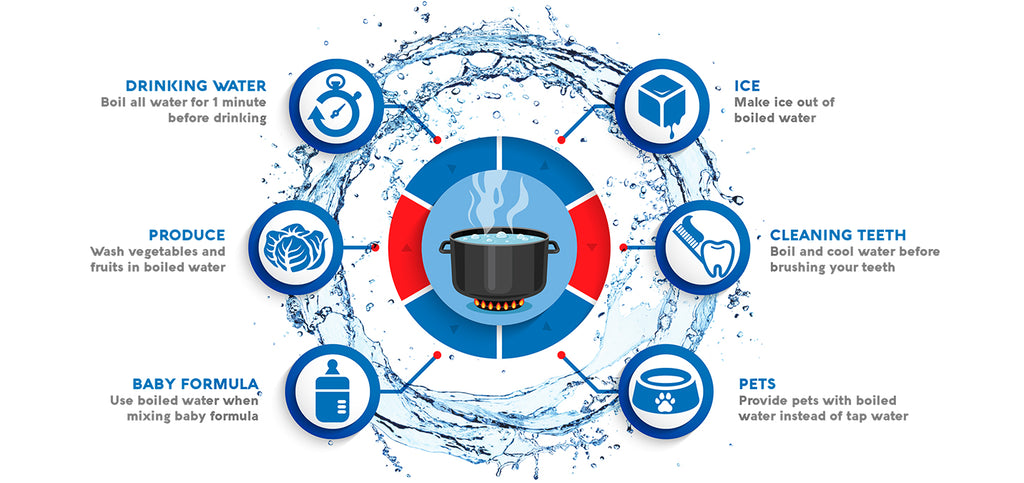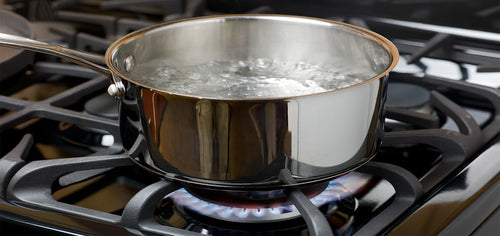What is a Boil Water Advisory?
A boil water advisory, also called a boil order, is issued in emergency situations when a local water supply may be contaminated with germs that cause illness or disease. Boil water advisories are caused by natural disasters like hurricanes, flooding, water pipe breakage, and chemical spills, or when there is known microbiological contamination in the water supply. Boil orders are also issued when water pressure drops below 20 psi, as low pressure allows bacteria to backwash into the water pipes.
During a boil water advisory (BWA), it is vital that you only drink boiled water, disinfected water, or bottled water. Boiling or disinfecting your drinking water will eliminate disease-causing microorganisms, safeguarding your health until the boil water advisory is lifted.
What contaminants might be in my water?
When water lines are compromised by damage or disasters, contaminants can enter the water supply. Bacteria, Cryptosporidium, Giardia, E. coli, and viruses are the most common contaminants during a boil water advisory. These contaminants are rarely life-threatening, but they can make people very sick. Younger children, elderly people, and those with compromised immune systems are the most at risk of falling ill. These organisms primarily affect the gastrointestinal system, causing diarrhea, abdominal cramps, nausea, and vomiting with or without a fever. Boiling water will neutralize bacteria that has polluted your water supply, keeping you and your family safe during a boil order.

How long should I boil water to ensure it is safe?
To kill harmful microorganisms during a boil water advisory, bring the water to a rolling boil for at least 1 minute (or 3 minutes for altitudes greater than 6,500ft). Then, allow the water to cool naturally, and safely store it in clean, covered containers. Though boiling is very effective at removing bacteria, viruses, and protozoa from water, keep in mind it will not eliminate other contaminants, like heavy metals, salts, and chemicals.
Do I need to boil my tap water if it is filtered?
Yes, it is important to boil all tap water even if it has been filtered. Most water filters (activated carbon, charcoal, pitcher filters, etc.) are not suitable for use on microbiologically unsafe water and do not kill bacteria or viruses. Activated carbon filters are great at removing organic compounds that pollute the taste and smell of water, but they are not designed to remove unsafe biological contaminants on their own. If a boil water advisory is in effect, your filtered water is still at risk for contamination. Even if you have a fridge or ice filter, do not use ice from ice trays, dispensers, or ice makers. Instead, make your own ice with boiled or bottled water.
Furthermore, after the boil water advisory has been lifted, it is important you discard and replace your water filter. If water was run through the filter during the boil order, the filter itself could have become contaminated.
Do I need to boil my water if I have a reverse osmosis system?
Although not designed for biological pathogen removal, RO, ultrafiltration, and other absolute rated sub-micron filters may reduce them. If your reverse osmosis system is operating properly, you do not have to boil your water. However, all filters and pre-filters should be replaced and system and storage tank sanitized after the order is lifted. If the boil water advisory lasted for longer than a day, you will need to replace your RO membrane as well. If you have any reason to believe your reverse osmosis system may not be functioning optimally, do not trust it to remove contaminants from your water. Instead, use water that has been boiled, bottled, or otherwise disinfected.
A UV purification system is the safest way to purify water during a boil water advisory. UV purifiers use ultraviolet light to disrupt the DNA of microorganisms. Exposure to ultraviolet light targets the genetic code of the organisms, rendering them unable to reproduce or function. This altogether eliminates any bacterial or viral threat posed by the organism. UV purification is one of the most effective methods of filtering microbiologically unsafe water. If you have a UV system installed, there is no need to boil your water.
What do I do if I don’t have power during a boil water advisory?
If you are without power during a boil water advisory, only use bottled, previously boiled, or treated water until the advisory clears. If you do not have bottled water and are unable to boil water, unscented household bleach may be used as a disinfectant. Be sure to use chlorine bleach that is suitable for disinfection and sanitization. Using a clean dropper, add 8 drops (about ⅛ of a teaspoon) of undiluted bleach to a gallon of contaminated water. Stir the water, and allow it to stand for 30 minutes. If the water is cloudy afterward, repeat the process. The water may have a chlorine odor to it, but it is safe for consumption. Depending on the amount of sodium hypochlorite in the bleach, you may need to adjust how much you add to the water.
| Volume of Water | Amount of 6% Bleach to Add | Amount of 8.25% Bleach to Add |
| 1 quart/liter | 2 drops | 2 drops |
| 1 gallon | 8 drops | 6 drops |
| 2 gallons | 16 drops (1/4 teaspoon) | 12 drops (1/8 teaspoon) |
| 4 gallons | 1/3 teaspoon | 1/4 teaspoon |
| 8 gallons | 2/3 teaspoon | 1/2 teaspoon |
When preparing disinfected drinking water, always take safety precautions. Use the bleach in a well-ventilated area and avoid skin contact.
Other methods of disinfection
- Iodine: Common household iodine, also called “tincture of iodine,” is found in many first aid kits and medicine cabinets. In a clean dropper, add five drops of 2% iodine to every liter or quart you are disinfecting.
- Disinfection Tablets: Iodine tablets, chlorine tablets, and other disinfecting agents are commercially available in most pharmacies. These can also effectively disinfect your water if you are unable to boil it. As they are sold in varying strengths, it is best to follow the manufacturer’s instructions printed on the label.
Boil water advisory FAQs
How should I prepare food during a boil water advisory?
During a boil water advisory, any water used in the cooking process should be bottled, boiled, or treated. Wash all fruits and vegetables in boiled, disinfected, or bottled water. Even if you are boiling water as part of the cooking process, it is important to bring the water to a full rolling boil for at least one minute before any food is added.
Most coffee makers cannot maintain high enough temperatures to ensure contaminant-free water. Use water that has been boiled and cooled to brew coffee, or any other beverage requiring the addition of water.
How do I safely prepare baby formula during a boil water advisory?
If possible, use bottled water when preparing powdered or concentrated baby formula. Take every precaution to ensure that your baby does not ingest tap water during a boil water advisory, as their immune systems are the most susceptible to illness. If you do not have access to bottled water, bring water to a rolling boil for at least two minutes (five minutes for altitudes above 6,500 ft) before allowing it to cool and mixing it with formula. Sterilize all bottles, rings, and nipples in boiling water for at least two minutes before use.
How do I wash dishes during a boil water advisory?
To hand wash dishes during a boil water advisory, clean them with hot, soapy water, rinse them like normal, and let them sit in a chlorine bleach solution for one minute. To prepare the bleach solution, add one tablespoon of unscented bleach to one gallon of hot, soapy water. Allow the dishes and silverware to completely air dry before storage.
You can use your home dishwasher if the hot wash reaches at least 150° Fahrenheit and includes a full dry cycle. While most home dishwashers reach these temperatures, some do not. If you are unsure of the temperature of your dishwasher, hand wash all dishes to be safe.
Is it safe to shower during a boil water advisory?
It is safe to bathe and shower during a boil water advisory, but be careful not to swallow any of the contaminated water while doing so. Give children a sponge bath to reduce the chances of them ingesting any water. Consider using boiled water that has been cooled, disinfected water, or bottled water to bathe babies. If you suffer from chronic illness or have any cuts or open wounds, consider bathing yourself in water that has been boiled. This minimizes the chances of infection setting in.
Can I brush my teeth during a boil water advisory?
Only use boiled, disinfected, or bottled water when brushing your teeth. Swallowing even a small amount of contaminated water can cause waterborne illness.
Do I need to boil water for my pets?
Just like their owners, pets are susceptible to waterborne pathogens and the diseases they bring. To keep your pet healthy, only serve them water that has been boiled and cooled, bottled, or otherwise disinfected until the boil water advisory is lifted.
How do I flush my water system after the boil water advisory is removed?
There are several steps to flushing water pipes and water systems at your home or business. Ensure that you follow the below steps in the listed order.
- Discard all water and ice. Throw away all ice cubes, drinks, baby formula, and uncooked food (like soup) prepared with contaminated water during the day of the advisory. Empty out soda makers and coffee makers that have water storage in the machine.
- Flush all hot water taps. Begin with the tap at the highest level in your home or business (for example, the bathroom on the second floor). Flush all hot taps including baths and showers for at least 5 minutes. This will clear out the pipes, fixtures, and hot water tank.
- Flush all cold water taps. Once hot taps have been flushed, flush all cold water taps, beginning with those at the highest level, for at least 5 minutes. This includes kitchens, bathrooms, wet bars, and utility sinks. Don't forget to flush the refrigerator's water dispensing system as well.
- Flush all appliances. Flush all remaining faucets and appliances including hose bibs, external faucets, or fixtures not used for drinking water. Follow the manufacturer's instructions for cleaning and sterilizing CPAP machines, humidifiers, and other medical or health care devices that have had contact with water. Make sure to manually regenerate water softeners as well.
- Replace all filters. Once the pipes and fixtures have been flushed, sediment filters for whole house filtration, reverse osmosis pre-filters, refrigerator filters, and other point-of-use filters should also be changed. If the boil advisory is only in effect for a few hours, your reverse osmosis membrane should be fine. However, if your reverse osmosis system has been sitting idle for a day or more, it may have bacteria growing in it. In such instances, the membrane should also be replaced
Is my well water safe after a flood?
Well water requires detailed cleaning and sterilization method after major flooding. It is difficult for a homeowner to thoroughly disinfect their own wells after flooding, so it is recommended you contact a well or pump contractor after the flood. Once the flood water recedes, a professional must inspect the well and initiate a testing and treatment process. For more information, see this informative outline from the EPA.
If you have any additional questions, please do not hesitate to contact us.
